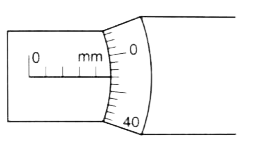In an experiment to measure the diameter of a wire using a screw gauge of resolution 0.001 cm, which of the following may correctly represent the measurement?
01.235 cm
01.2351 cm
01.24 cm
0.1.23500 cm
The correct Answer is:1
To solve the problem of measuring the diameter of a wire using a screw gauge with a resolution of 0.001 cm, we can follow these steps:
1. Understand the Resolution of the Screw Gauge:
The resolution (or least count) of the screw gauge is given as 0.001 cm. This means that the smallest measurement that can be accurately read from the screw gauge is 0.001 cm.
2. Determine the Number of Decimal Places:
Since the resolution is 0.001 cm, the measurement should be reported to three decimal places. This is because the last digit in the measurement should reflect the precision of the instrument being used.
3. Evaluate the Measurement Options:
We need to look at the options provided (not listed here) and determine which one correctly represents a measurement that is reported to three decimal places.
4. Identify Incorrect Options:
- Any option that reports the measurement with fewer than three decimal places (e.g., 0.1 cm or 0.01 cm) is incorrect.
- Any option that reports the measurement with more than three decimal places (e.g., 0.0001 cm or 0.00001 cm) is also incorrect.
5. Select the Correct Option:
The correct option will be the one that reports the measurement with exactly three decimal places, such as 0.123 cm.
Conclusion:
Based on the analysis, the correct representation of the measurement of the diameter of the wire using the screw gauge should be to three decimal places.
The resolution (or least count) of the screw gauge is given as 0.001 cm. This means that the smallest measurement that can be accurately read from the screw gauge is 0.001 cm.
Since the resolution is 0.001 cm, the measurement should be reported to three decimal places. This is because the last digit in the measurement should reflect the precision of the instrument being used.
We need to look at the options provided (not listed here) and determine which one correctly represents a measurement that is reported to three decimal places.
- Any option that reports the measurement with fewer than three decimal places (e.g., 0.1 cm or 0.01 cm) is incorrect.
- Any option that reports the measurement with more than three decimal places (e.g., 0.0001 cm or 0.00001 cm) is also incorrect.
The correct option will be the one that reports the measurement with exactly three decimal places, such as 0.123 cm.
Based on the analysis, the correct representation of the measurement of the diameter of the wire using the screw gauge should be to three decimal places.
Topper's Solved these Questions
- UNITS AND MEASUREMENTSBOOK - AAKASH INSTITUTE ENGLISHCHAPTER - UNITS AND MEASUREMENTSEXERCISE - ASSIGNMENT SECTION C Objective (More than one option is correct )
10 Videos
- UNITS AND MEASUREMENTSBOOK - AAKASH INSTITUTE ENGLISHCHAPTER - UNITS AND MEASUREMENTSEXERCISE - ASSIGNMENT SECTION D (Linked Comprehension)
3 Videos
- UNITS AND MEASUREMENTSBOOK - AAKASH INSTITUTE ENGLISHCHAPTER - UNITS AND MEASUREMENTSEXERCISE - ASSIGNMENT SECTION A Objective (One option is correct )
50 Videos
- THERMODYNAMICSBOOK - AAKASH INSTITUTE ENGLISHCHAPTER - THERMODYNAMICSEXERCISE - ASSIGNMENT (SECTION -D) (Assertion - Reason Type Questions)
10 Videos
- WAVE OPTICSBOOK - AAKASH INSTITUTE ENGLISHCHAPTER - WAVE OPTICSEXERCISE - Assignment (Section-J (Aakash Challengers question))
1 Videos
Similar Questions
A student measured the diameter of a wire using a screw gauge with least count 0.001cm and listed the measurement. The correct measurement is
View SolutionThe diameter of a wire is measured with a screw gauge having least count 0.01mm. Out of the following the one which correctly expresses its diameter is
View Solution
Knowledge Check
Which of the following instrument is used to measure gauge pressure ?
AThermometerBBarometerCManometerDHydrometer
In searle's experiment, the diameter of the wire, as measured by a screw gauge of least count 0.001 cm is 0.500 cm. The length, measured by a scale of least count 0.1cm is 110.0cm. When a weight of 40N is suspended from the wire, its extension is measured to be 0.125 cm by a micrometer of least count 0.001 cm. Find the Young's modulus of the meterial of the wire from this data.
View SolutionThe diameter of a wire is measured as 0.25 cm using a screw gauge of least count 0.005 cm. The percentage error is
View SolutionConductance measurements and be used to detect the end point of acid-base titrations. Which of the following plots correctly represents the end point of the titration of strong acid and a strong base?
View SolutionA student measued the diameter of a small steel ball using a screw gauge of least count 0.001cm. The main scale reading is 5mm and zero of circular scale division coincides with 25 divisions above the reference level. If screw gauge has a zero erroof −0.004cm, the correct diameter of the ball is
View SolutionThickness of a pencil measured by using a screw gauge (least count.001 cm) comes out to be 0.802 cm .The percentage error in the measurement is
View SolutionThe diameter of a wire as measured by a screw gauge was found to be 1.002 cm, 1.000 cm, 1.006 cm .The absolute error in the second reading is
View SolutionFig. below shows the reading obtained while measuring the diameter of a wire with a screw gauge. The screw advances by 1 division on main scale when circular head is rotated once.

Find the diameter of the wire.
View Solution
